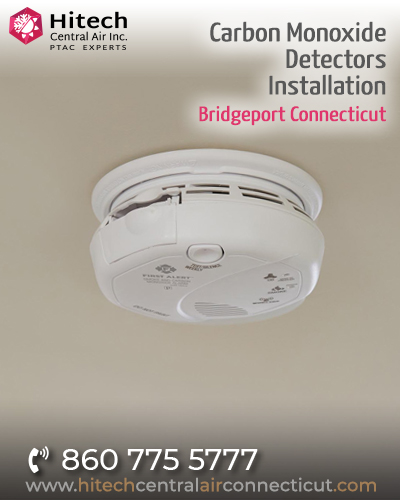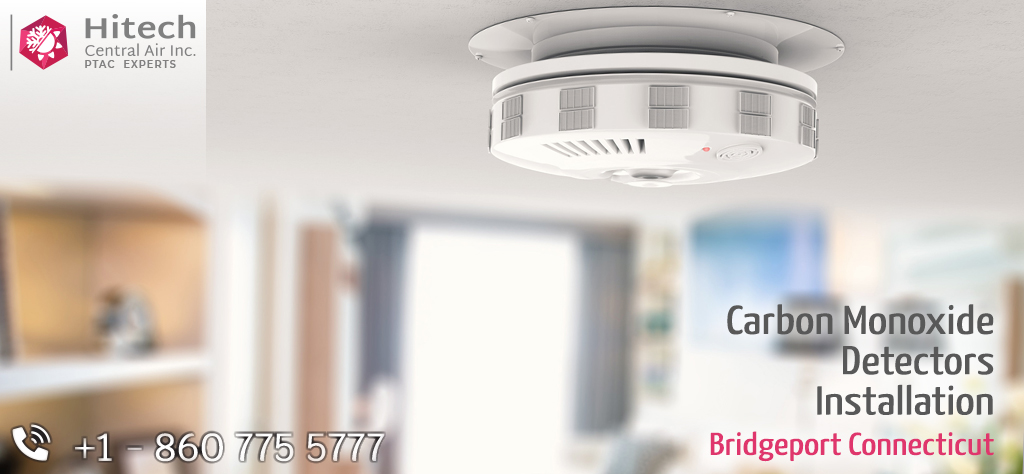Hitech Central Air Connecticut
Carbon Monoxide Detectors Installation Bridgeport CT

According to the National Fire Protection Association, carbon monoxide (CO) detectors should be installed in every sleeping area in a dwelling. The International Association of Fire Chiefs recommends a CO detector on every floor of your home, including the basement.
Positioning and maintaining your carbon monoxide alarm
Carbon monoxide (CO) alarms are the most effective way to detect carbon monoxide in the air and alert you to the presence of the dangerous gas.
Carbon monoxide consists of one part oxygen and one part carbon and is produced by partially burned carbon fuel sources like natural gas, coal, petrol, wood and propane. While harmless in an outdoor or well ventilated area, carbon monoxide can be lethal in enclosed spaces. It is very difficult to detect because of its lack of odour and excess carbon monoxide starves the body of oxygen by combining with haemoglobin in the lungs. This can causes headaches, dizziness and nausea, before ultimately becoming fatal.
Where to place a carbon monoxide detector
In order for your carbon monoxide alarm to work correctly, it is essential you put it in the right place. Here are the things you need to consider when placing a carbon monoxide detector:
- You should ideally have a carbon monoxide detector on each floor of your house and definitely in the same room as any fuel-burning appliance, such as a boiler, stove or oven.
- Place the alarm at head height. This could be on a shelf or bookcase; it doesn’t have to be fixed on a wall. Ideally, it should be
-
- At least 300 mm from any wall (for ceiling mounted alarms)
- At least 150 mm from the ceiling, above the height of any door or openable window (for wall mounted alarms)
- Make sure the alarm is between 1 and 3 m (measured horizontally) from the potential source of CO, such as boilers and ovens.
- Some carbon monoxide alarms are built into ceiling-mounted multipurpose fire alarms. You should check your smoke detector to see whether it is already fitted with a carbon monoxide detector. If the alarm is located on the ceiling, it should be at least 300 mm from any wall and any ceiling obstruction e.g. light fittings.

CO alarms must not be placed:
- Too near your fireplace or any appliance that produces flames (like your gas hob).
- In an enclosed space such as behind furniture or in a cupboard
- Where it can be obstructed.
- Directly above a sink.
- Next to an external door, window or ventilation equipment such as extractor fans, air vents or similar ventilation opening.
- Where the temperature may drop below –5 ºC or exceed 40 ºC (this can vary by manufacturer, please check the user manual).
Carbon monoxide alarm maintenance
You should think of the maintenance of your carbon monoxide alarm in the same terms as your smoke alarm. This means that it’ll require regular checks to ensure that it’s in working order, these should include:
- Test the ‘beep’ on the alarm at least once a week. You could set a reminder on your phone to remind you.
- Ensure batteries are changed, if necessary, at least once a year, and that you test the function immediately after changing.
- Pay attention to any ‘chirps’ from your alarm. These could be a warning of low batteries.
- Pay close attention to the alarm’s battery life and when it will need replacing. Most alarms will last between five and seven years, with some lasting for as long as 10 years.
Always read and follow the manufacturer’s instructions when placing, testing, and servicing the alarm.
How many carbon monoxide detectors should I have?
This depends on the size of your home. We recommend you have a carbon monoxide detector on every level of your home. These should be in rooms with fuel‑burning appliances as well as outside bedrooms. This includes basements and the garages.
Which carbon monoxide alarm should I buy?
Carbon monoxide alarms work like smoke or fire alarms, going off as soon as they detect surplus carbon monoxide in the air. There are three kinds of carbon monoxide detectors, all of which work slightly differently:
- Biomimetic sensor: The alarm is set off by a colour-changing gel, which changes when it absorbs a certain level of carbon monoxide and triggers the warning.
- Metal oxide semiconductor: Carbon monoxide reduces the electrical resistance in an electronic circuit, which trips the alarm and sets it off.
- Electrochemical sensor: Changes in electrical currents, caused by the presence of carbon monoxide, in a chemical solution are detected by submerged electrodes. This then triggers the alarm.






